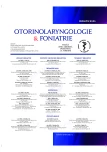Measurement of oropharyngeal pH in the diagnosis of laryngopharyngeal reflux
Authors:
Š. Konečný 1,2; J. Bindasová 1,3; L. Krnáčová 1,3; Jiří Dolina 1,2; M. Šteffl 1,2
Authors‘ workplace:
Lékařská fakulta, Masarykova univerzita, Brno
1; Interní gastroenterologická klinika, Fakultní nemocnice Brno
2; Oddělení ORL, Fakultní nemocnice Brno
3
Published in:
Otorinolaryngol Foniatr, 69, 2020, No. 2, pp. 90-94.
Category:
Case Reports
Overview
Symptoms caused by laryngopharyngeal reflux (LPR) are a common cause of examination in ENT outpatient clinics, but its diagnosis is challenging. 24 hour oropharyngeal pH monitoring by Restech system is a new diagnostic method to detect LPR. In our case report we present a patient who visited several different specialists and underwent series of examinations due to suspicion of LPR and finally use of Restech system led to a diagnosis followed by successful therapy
Keywords:
laryngopharyngeal reflux – gastroesophageal reflux – Restech – Dx-pH
Sources
1. Ayazi, S., Lipham, J. C., Hagen, J. A., et al.: A new technique for measurement of pharyngeal pH: normal values and discriminating pH threshold. J Gastrointest Surg, 13, 2009, 8, s. 1422–1429.
2. Becker, V., Graf, S., Schlag, C., et al.: First agreement analysis and day-to-day comparison of pharyngeal pH monitoring with pH/impedance monitoring in patients with suspected laryngopharyngeal reflux. J Gastrointest Surg, 16, 2012, 6, s. 1096–1101.
3. Duricek, M., Banovcin, P., Halickova, T., et. al.: Acidic pharyngeal reflux does not correlate with symptoms and laryngeal injury attributed to laryngopharyngeal reflux. Dig Dis Sci, 64, 2019, 5, s. 1270–1280.
4. Gyawali, C. P., Kahrilas, P. J., Savarino, E., et al.: Modern diagnosis of GERD: the Lyon Consensus. GUT, 67, 2018, 7, s. 1351–1362.
5. Haličková, T., Nosáková, L., Michalová, R.: Refluxná záťaž v hypofaryngu podľa dvojkanálovej pH/Z nekoreluje s Reflux Finding Score u pacientov s laryngofaryngeálnym refluxom. Otorinolaryngol Foniatr, 67, 2018, 2, s. 60–66.
6. Koufman, J. A.: Laryngopharyngeal reflux is different from classic gastroesophageal reflux disease. Ear Nose Throat J, 81, 2002, 9 (Suppl 2), s. 7–9.
7. Koufman, J. A.: The otolaryngologic manifestations of gastroesophageal reflux disease (GERD): a clinical investigation of 225 patients using ambulatory 24-hour pH monitoring and an experimental investigation of the role of acid and pepsin in the development of laryngeal injury. Laryngoscope, 101, 1991, 4 (Pt 2 Suppl 53), s. 1–78.
8. Mazzoleni, G., Vailati, C., Lisma, D. G., et al.: Correlation between oropharyngeal pH-monitoring and esophageal pH-impedance monitoring in patients with suspected GERD-related extra-esophageal symptoms. Neurogastroenterol Motil, 26, 2014, 11, s. 1557–1564.
9. Samuels, T. L., Johnston, N.: Pepsin as a causal agent of inflammation during nonacidic reflux. Otolaryngol Head Neck Surg, 141, 2009, 5, s. 559–563.
10. Sereg-Bahar, M., Jerin, A., Jansa, R., et al.: Pepsin and bile acids in saliva in patients with laryngopharyngeal reflux - a prospective comparative study. Clin Otolaryngol, 40, 2015, 3, s. 234–239.
11. Sifrim, D., Mittal, R., Fass, R., et al.: Review article: acidity and volume of the refluxate in the genesis of gastro-oesophageal reflux disease symptoms. Aliment Pharmacol Ther, 25, 2007, 9, s. 1003–1017.
12. Ummarino, D., Vandermeulen, L., Roosens, B., et al.: Gastroesophageal reflux evaluation in patients affected by chronic cough: Restech versus multichannel intraluminal impedance/pH metry. Laryngoscope, 123, 2013, 4, s. 980–984.
13. Wong, R. K., Hanson, D. G., Waring, P. J., et al.: ENT manifestations of gastroesophageal reflux. Am J Gastroenterol, 95, 2000, 8 (Suppl), s. 15–22.
14. Zeleník, K., Čáp, P., Chlumský J., et al.: Mimojícnové projevy refluxní choroby. 1. vyd. Havlíčkův Brod, Tobiáš, 2013.
Labels
Audiology Paediatric ENT ENT (Otorhinolaryngology)Article was published in
Otorhinolaryngology and Phoniatrics

2020 Issue 2
Most read in this issue
- Measurement of oropharyngeal pH in the diagnosis of laryngopharyngeal reflux
- COVID-19 from the point of view of an otorhinolaryngologist, an overview of the situation two months after the first cases of infection in our countries; evidence based
- Cervical hematoma caused by parathyroid adenoma
- Cone-beam Computed Tomography (CBCT) of temporal bone after cochlear implantation – first experiences
